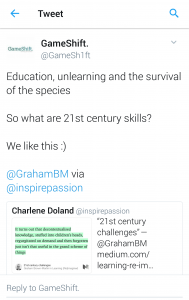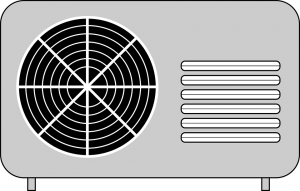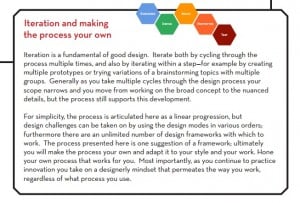#PBL as a #process within a #framework
Recently, a team of five #Meliora students uploaded a newly refined version of their history fair project. Next week, they will be competing at Illinois History Day, the last step in their quest to qualify as national contestants.
National History Day (#NHD) provides a good example of the Project-Based Learning (#PBL) #process and #lifecycle. Students are first challenged at a local/school level to create a project, within a specified #framework. As pointed out in the High Quality Project Based Learning Framework, and by John Spencer, high-quality PBL is not a free-for-all, but rather #learnercentered work conducted within the boundaries of a defined structure.
The NHD project framework consists of the following specific criteria:
- Must strongly incorporate the annual #theme (the 2018-2019 theme is “Triumph & Tragedy in History”).
- A choice of five categories: paper; exhibit; performance; documentary; or website. This variety offers students abundant #voice and #choice in the product they create. Ultimately, the product serves as their primary #evidence of #learning.
- Constraints for each project category. For example, documentaries cannot exceed ten minutes in length. Conversely, they should not be much less than ten minutes long, (an unspoken rule) because if students cannot find ten minutes of evidence to support their argument, it suggests they have not looked into their topic deeply enough.
- Supplementary documentation, including an annotated bibliography and a process (#reflection) paper.
- #Public #presentation (#communication) before a panel of judges at each level of competition. The judges use identical evaluation criteria for each category of project, focusing on the clarity and strength of the argument the students develop in defense of their thesis statement.
Nearly every discipline uses a framework or blueprint for their creative work, it’s a writer’s workshop structure, an engineering process, the scientific method, or a design thinking framework. ~ John Spencer
Students have complete voice and choice in the topic they explore, as long as their thesis and argument fit within the framework. In past years, Meliora students have explored topics as diverse as “The Tucker Torpedo,” Women’s Suffrage, Michael Jordan (national contender) and Soul Train (national contender). The topics chosen reflect the students’ interests, while at the same time requiring them to conduct thorough research.
In many cases, the students started their journey with superficial knowledge. As they dug deeper, their knowledge and critical analysis expanded. Not only did they learn more about their chosen topic, but more importantly (shhhhh, don’t tell them), they developed a much deeper understanding of the historical context, content, and relevance.
In my role as #facilitator, I did not “teach” them about their topic. Rather, I asked them many open-ended questions: “Why did [event] happen?” “What else was happening in the [country, world] at the time?” “What was life like at that time?” “How do you know?” I also helped them locate resources, and persistently asked them to use proper research methods.
This year, the most significant #mindset growth this team made was arguably related to an interview they conducted. That one 20-minute activity (plus the preparation work) exponentially boosted their confidence and their belief that they have significance, not only in the teen world, but also the adult world.
As I also write here, students who participate in National History Day create multiple #iterations of their product, refining their work between each level of competition. Since the project framework remains constant, they invariably are faced with making tough decisions as to which evidence is most relevant to their thesis argument. There is frequent anguish as they remove a favorite quote or an image they love, even as they recognize that a particular element is less important than others they need to include.
This refinement process is an excellent tool for helping the students develop #criticalthinking skills. When they are struggling to make decisions and ask my advice, my standard response is, “In what way does it support your thesis?” Often accompanied by sighs and groans, they make the correct decision.
This is the documentary going to competition next week:
For the truly dedicated, here is the team’s first version:







